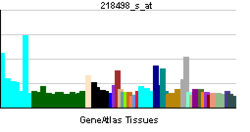ERO1L
| View/Edit Human | View/Edit Mouse |
ERO1-like protein alpha is a protein that in humans is encoded by the ERO1L gene.[3][4]
Interactions
ERO1L has been shown to interact with TXNDC4[5] and P4HB.[5][6]
References
- ↑ "Human PubMed Reference:".
- ↑ "Mouse PubMed Reference:".
- ↑ Cabibbo A, Pagani M, Fabbri M, Rocchi M, Farmery MR, Bulleid NJ, Sitia R (Mar 2000). "ERO1-L, a human protein that favors disulfide bond formation in the endoplasmic reticulum". J Biol Chem. 275 (7): 4827–33. doi:10.1074/jbc.275.7.4827. PMID 10671517.
- ↑ "Entrez Gene: ERO1L ERO1-like (S. cerevisiae)".
- 1 2 Anelli, Tiziana; Alessio Massimo; Mezghrani Alexandre; Simmen Thomas; Talamo Fabio; Bachi Angela; Sitia Roberto (Feb 2002). "ERp44, a novel endoplasmic reticulum folding assistant of the thioredoxin family". EMBO J. England. 21 (4): 835–44. doi:10.1093/emboj/21.4.835. ISSN 0261-4189. PMC 125352
 . PMID 11847130.
. PMID 11847130. - ↑ Mezghrani, A; Fassio A; Benham A; Simmen T; Braakman I; Sitia R (Nov 2001). "Manipulation of oxidative protein folding and PDI redox state in mammalian cells". EMBO J. England. 20 (22): 6288–96. doi:10.1093/emboj/20.22.6288. ISSN 0261-4189. PMC 125306
 . PMID 11707400.
. PMID 11707400.
Further reading
- Pagani M, Fabbri M, Benedetti C, et al. (2000). "Endoplasmic reticulum oxidoreductin 1-lbeta (ERO1-Lbeta), a human gene induced in the course of the unfolded protein response.". J. Biol. Chem. 275 (31): 23685–92. doi:10.1074/jbc.M003061200. PMID 10818100.
- Benham AM, Cabibbo A, Fassio A, et al. (2000). "The CXXCXXC motif determines the folding, structure and stability of human Ero1-Lalpha.". EMBO J. 19 (17): 4493–502. doi:10.1093/emboj/19.17.4493. PMC 302061
 . PMID 10970843.
. PMID 10970843. - Pagani M, Pilati S, Bertoli G, et al. (2001). "The C-terminal domain of yeast Ero1p mediates membrane localization and is essential for function.". FEBS Lett. 508 (1): 117–20. doi:10.1016/S0014-5793(01)03034-4. PMID 11707280.
- Mezghrani A, Fassio A, Benham A, et al. (2002). "Manipulation of oxidative protein folding and PDI redox state in mammalian cells.". EMBO J. 20 (22): 6288–96. doi:10.1093/emboj/20.22.6288. PMC 125306
 . PMID 11707400.
. PMID 11707400. - Anelli T, Alessio M, Mezghrani A, et al. (2002). "ERp44, a novel endoplasmic reticulum folding assistant of the thioredoxin family.". EMBO J. 21 (4): 835–44. doi:10.1093/emboj/21.4.835. PMC 125352
 . PMID 11847130.
. PMID 11847130. - Tsai B, Rapoport TA (2002). "Unfolded cholera toxin is transferred to the ER membrane and released from protein disulfide isomerase upon oxidation by Ero1.". J. Cell Biol. 159 (2): 207–16. doi:10.1083/jcb.200207120. PMC 2173060
 . PMID 12403808.
. PMID 12403808. - Strausberg RL, Feingold EA, Grouse LH, et al. (2003). "Generation and initial analysis of more than 15,000 full-length human and mouse cDNA sequences.". Proc. Natl. Acad. Sci. U.S.A. 99 (26): 16899–903. doi:10.1073/pnas.242603899. PMC 139241
 . PMID 12477932.
. PMID 12477932. - Gess B, Hofbauer KH, Wenger RH, et al. (2003). "The cellular oxygen tension regulates expression of the endoplasmic oxidoreductase ERO1-Lalpha.". Eur. J. Biochem. 270 (10): 2228–35. doi:10.1046/j.1432-1033.2003.03590.x. PMID 12752442.
- Clark HF, Gurney AL, Abaya E, et al. (2003). "The secreted protein discovery initiative (SPDI), a large-scale effort to identify novel human secreted and transmembrane proteins: a bioinformatics assessment.". Genome Res. 13 (10): 2265–70. doi:10.1101/gr.1293003. PMC 403697
 . PMID 12975309.
. PMID 12975309. - Anelli T, Alessio M, Bachi A, et al. (2003). "Thiol-mediated protein retention in the endoplasmic reticulum: the role of ERp44.". EMBO J. 22 (19): 5015–22. doi:10.1093/emboj/cdg491. PMC 204474
 . PMID 14517240.
. PMID 14517240. - Bertoli G, Simmen T, Anelli T, et al. (2004). "Two conserved cysteine triads in human Ero1alpha cooperate for efficient disulfide bond formation in the endoplasmic reticulum.". J. Biol. Chem. 279 (29): 30047–52. doi:10.1074/jbc.M403192200. PMID 15136577.
- Molteni SN, Fassio A, Ciriolo MR, et al. (2004). "Glutathione limits Ero1-dependent oxidation in the endoplasmic reticulum.". J. Biol. Chem. 279 (31): 32667–73. doi:10.1074/jbc.M404992200. PMID 15161913.
- van Lith M, Hartigan N, Hatch J, Benham AM (2005). "PDILT, a divergent testis-specific protein disulfide isomerase with a non-classical SXXC motif that engages in disulfide-dependent interactions in the endoplasmic reticulum.". J. Biol. Chem. 280 (2): 1376–83. doi:10.1074/jbc.M408651200. PMID 15475357.
- Gerhard DS, Wagner L, Feingold EA, et al. (2004). "The status, quality, and expansion of the NIH full-length cDNA project: the Mammalian Gene Collection (MGC).". Genome Res. 14 (10B): 2121–7. doi:10.1101/gr.2596504. PMC 528928
 . PMID 15489334.
. PMID 15489334. - May D, Itin A, Gal O, et al. (2005). "Ero1-L alpha plays a key role in a HIF-1-mediated pathway to improve disulfide bond formation and VEGF secretion under hypoxia: implication for cancer.". Oncogene. 24 (6): 1011–20. doi:10.1038/sj.onc.1208325. PMID 15592500.
- Otsu M, Bertoli G, Fagioli C, et al. (2006). "Dynamic retention of Ero1alpha and Ero1beta in the endoplasmic reticulum by interactions with PDI and ERp44.". Antioxid. Redox Signal. 8 (3-4): 274–82. doi:10.1089/ars.2006.8.274. PMID 16677073.
This article is issued from Wikipedia - version of the 6/6/2016. The text is available under the Creative Commons Attribution/Share Alike but additional terms may apply for the media files.
